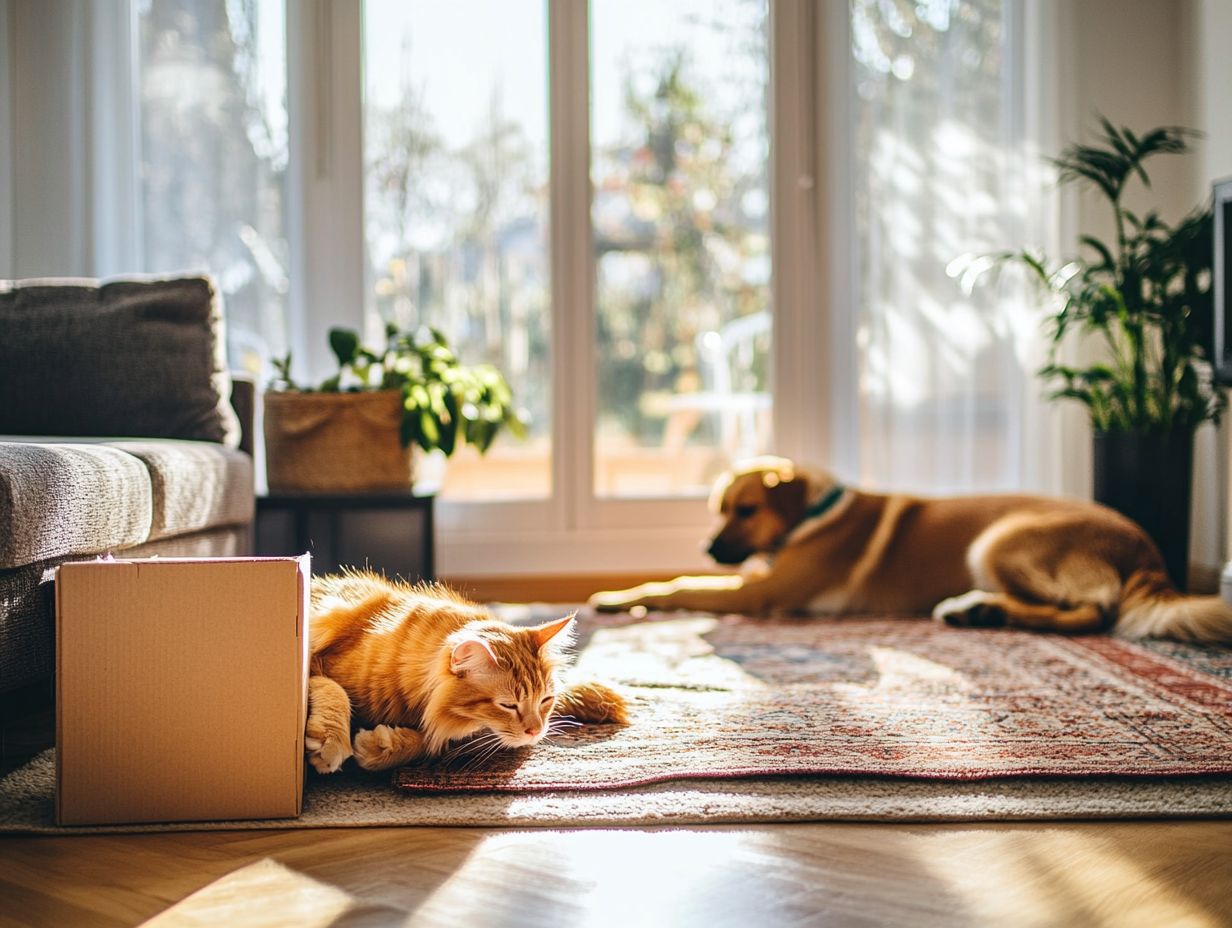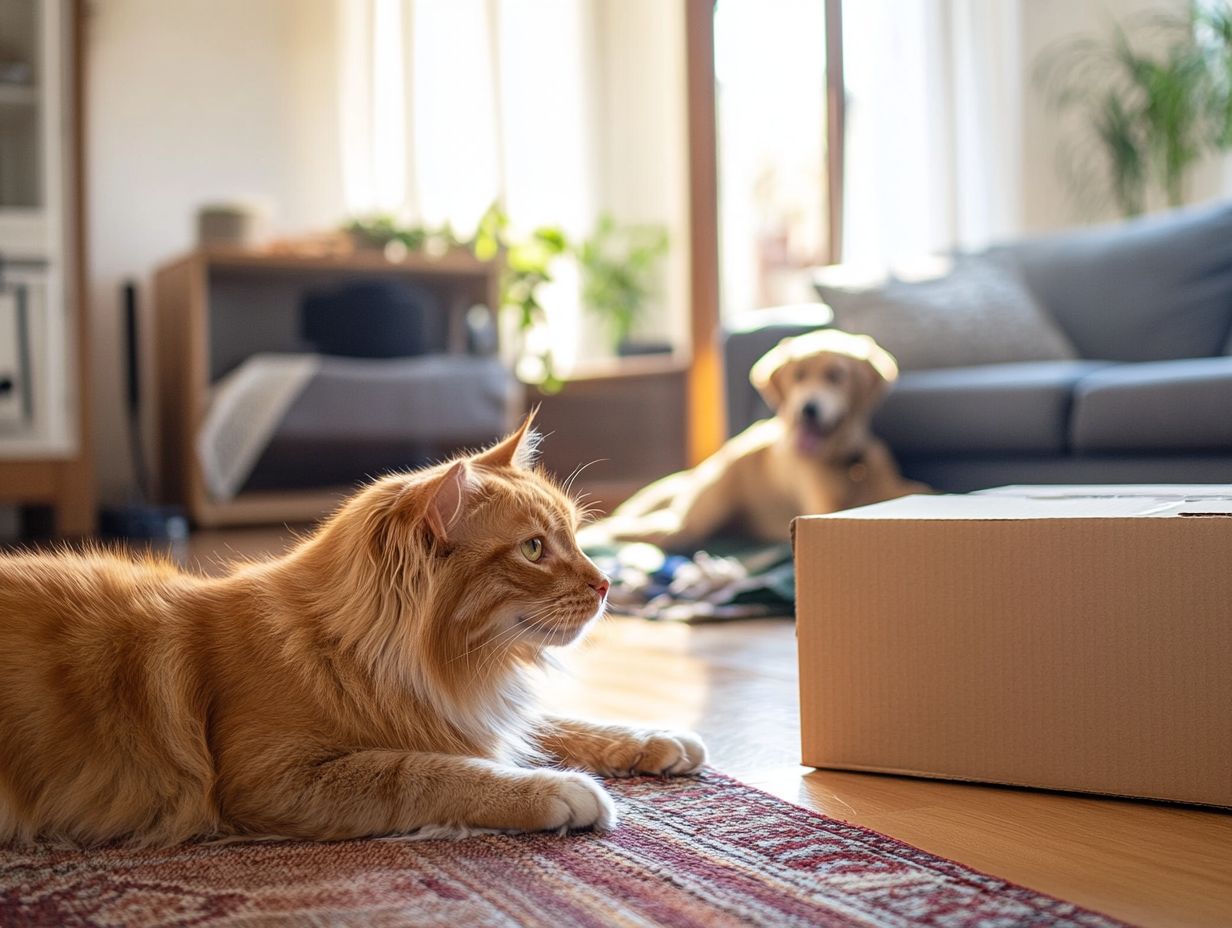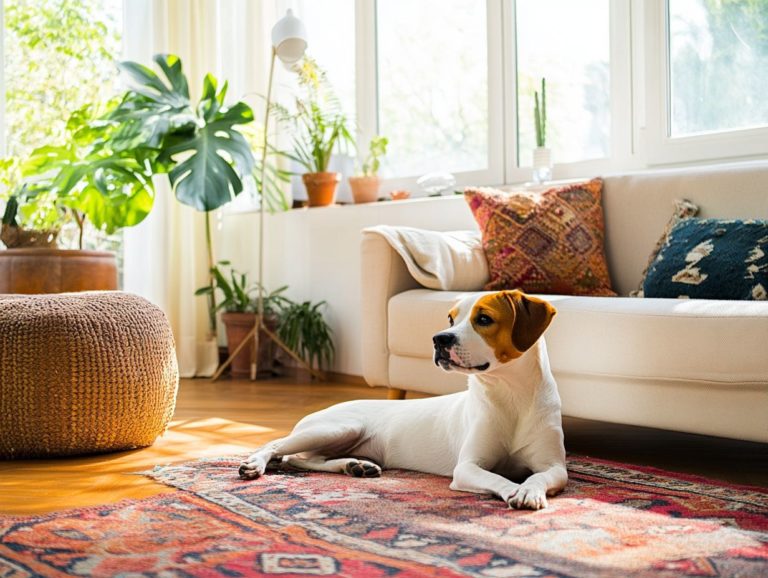How to Transition Pets to New Environments
Transitioning pets to new environments, especially when moving homes, is essential for their well-being and happiness.
Whether you re moving to a new home or introducing your beloved pets to a different family dynamic, understanding how to transition your pet smoothly is key to their comfort. This guide will empower you to create a safe and comfortable environment, introduce your pet gradually, establish routines, and monitor their adaptation.
With the right approach, you can enable your furry friend to start settling in and adjust seamlessly to their new surroundings.
Contents
- Key Takeaways:
- Understanding the Importance of a Smooth Transition
- Preparing for the Transition
- Introducing the Pet to the New Environment
- Settling In: Establishing Routines
- Monitoring and Addressing Any Challenges
- Frequently Asked Questions
- What is the best way to transition my pet to a new environment?
- How long should I take to transition my pet to a new environment?
- Should I change my pet’s routine during the transition to a new environment?
- What steps can I take to make the transition easier for my pet?
- How can I help my pet cope with the stress of transitioning to a new environment?
- When should I seek professional help during the transition process?
Key Takeaways:

- Transitioning to a new environment is crucial for the well-being of pets.
- Creating a safe and comfortable environment and obtaining necessary moving supplies are important steps in preparing for the transition.
- Gradually introducing routines can help pets settle into their new environment with ease.
Understanding the Importance of a Smooth Transition
Understanding how to transition your pet smoothly is key to their comfort. It profoundly influences your beloved pets’ comfort and security during this period of change, helping to alleviate their anxiety levels.
Pets, much like cherished family members, can experience heightened anxiety when removed from their familiar surroundings and thrust into a new environment. This transition impacts their emotional well-being and behavior, making it imperative for you to plan thoughtfully for their gradual introduction to facilitate their adjustment.
Why Transitioning is Important for Pets
Transitioning is crucial for pets, as it directly influences their anxiety levels and emotional well-being during the moving process. A new environment can be quite unsettling for them, especially when it disrupts their familiar surroundings.
Pets thrive on routine and comfort, and the chaos of packing, along with unfamiliar sights and new smells, can become a significant source of stress. To help alleviate this anxiety, ensuring a smooth transition is essential.
Focus on gradual introductions and routines. Creating a designated safe space in the new home, complete with their favorite toys and blankets, can provide a comforting sense of security and act as a safe haven.
Maintaining a consistent routine like feeding and walking schedules can ease the adjustment period, allowing your pets to gradually acclimate to their new surroundings.
Preparing for the Transition
Preparing for the transition on moving day is crucial for both you and your pets. It involves various planning steps that can make the relocation experience seamless and stress-free.
Creating a Safe and Comfortable Environment
Creating a safe and comfortable environment for your pets in a new home is essential, as it offers them a sense of security and belonging. Establish a designated area where your pets can retreat and relax.
This space should be adorned with familiar items like their favorite bed, cozy blankets, cherished toys, and their food dishes. These familiar comforts can significantly ease their transition into the new environment.
To promote relaxation, consider using products that help pets feel relaxed, spending quality time together, or playing soft music to cultivate a tranquil atmosphere. Maintaining a consistent daily routine, including feeding schedules and walks, will further help your pets adapt seamlessly.
Taking the time to spend quality moments with them in this safe haven fosters trust, allowing them to explore the rest of the home at their own pace.
Act fast to create a safe space for your pet it will make all the difference during this move! Start planning today for your pet s well-being.
Obtaining Necessary Supplies

Acquiring the necessary supplies for your pets, including various moving supplies, is a vital aspect of the moving process. This ensures you are thoroughly prepared for the transition ahead.
From sturdy crates to cozy bedding, having the right gear is essential for keeping your pets safe during the move. It also eases their adjustment to a new environment. Using eco-friendly packing materials, such as biodegradable wrapping paper and reusable containers, significantly contributes to aligning your moving efforts with sustainability goals.
This journey is about more than just a smooth move; transitioning to pet-friendly neighborhoods grants you access to public parks, local businesses, and services tailored for your furry companions. This makes both the journey and the destination more enjoyable and beneficial for everyone involved.
Introducing the Pet to the New Environment
Introducing your pet to a new environment demands careful planning and execution. This thoughtful approach ensures they adjust easily and feel secure in their fresh environment.
Addressing Any Behavioral Changes
Addressing any behavioral changes in your pet during the transition is essential to ensure they remain happy and healthy in their new environment.
Being attentive to subtle signs of stress or discomfort can make a significant difference. For instance, if you notice changes in their eating habits, increased vocalization, or withdrawal from their usual activities, these could indicate that your furry friend is struggling to adjust.
Monitoring their behavior over time while establishing a consistent routine will help you identify patterns and ease their anxieties. Creating a safe space can also provide them with comfort as they acclimate.
If troubling behaviors persist or worsen, consider reaching out to a trusted family member for support or consulting a professional pet behaviorist, who can offer effective strategies. This way, you can gain insights and tailored strategies to help your pet thrive.
Settling In: Establishing Routines
Establishing feeding routines, walking schedules, and playtime patterns for your pets is vital for their comfort and stability in a new home. By doing so, you promote a sense of normalcy that helps them adjust more easily to their surroundings.
Establishing Feeding and Exercise Routines
Establishing feeding and exercise routines for your pets is essential in helping them adapt to their new environment and maintain their overall well-being.
Consistency in these routines plays a significant role in providing your pets with a sense of security, particularly during transitions like moving to a new home. This enhances their emotional needs. By customizing meal times and walks to meet the unique needs of your furry companions, you create a predictable daily structure that enhances their comfort and confidence.
It’s also important to pay attention to any preferences or sensitivities they may have, incorporating activities that engage both their minds and bodies. Ultimately, a stable routine fosters emotional stability while promoting good physical health, ensuring that your pets thrive even in unfamiliar settings.
Creating a Sense of Familiarity

Creating a sense of familiarity in your new home is essential for addressing your pet’s emotional needs. This makes their transition smoother and enhances their comfort and security.
Incorporating familiar items from their previous environment can significantly contribute to cultivating that sense of stability. By setting up their favorite toys in easily accessible spots, you not only bring them joy but also provide comforting reminders of home. Placing their bedding in a cozy nook helps establish a safe space where they can retreat when feeling anxious.
These small adjustments, combined with consistent routines for feeding, playtime, and exercise, foster a soothing atmosphere. This ensures your pet feels secure and cherished as they adapt to their new surroundings.
In summary, carefully planning your pet’s transition and establishing routines can significantly improve their experience in a new home. By addressing their emotional needs and providing familiar items, you can help them feel secure and happy during this exciting time.
Monitoring and Addressing Any Challenges
Monitoring and addressing any challenges that arise during your pet’s transition is crucial for ensuring their well-being and happiness in their new home.
Being attentive to their needs and any adjustments they might require will make a significant difference in helping them settle in comfortably and feel a sense of normalcy.
Signs of Stress and How to Address Them
Recognizing the signs of stress in your pet during a transition is vital for meeting their emotional needs effectively. This awareness gives you the power to intervene swiftly and offer comfort, ensuring your furry companion feels secure.
Common indicators of stress include:
- Excessive barking
- Hiding
- Changes in appetite
- Destructive behaviors
Monitoring these indicators can help ease your pet’s anxiety. Watch these behaviors closely, as they can signal deeper issues related to their emotional needs.
To help alleviate stress, consider:
- Creating a cozy safe space for your pet
- Engaging them in regular exercise
- Using calming aids like soothing music or pheromone diffusers
Remember, each pet is unique, so experimenting with various stress relief techniques can lead to a happier, healthier companion and strengthen their social connections.
Seeking Professional Help, if Needed
Getting help from a pet expert can be very helpful if your pet shows persistent behavioral changes or distress during a transition period. A trained pet behaviorist can provide personalized strategies to ease their worries and restore stability, especially when moving day preparations feel overwhelming.
Consider involving other family members in this process, too; their support can cultivate a more secure environment for your pet. Addressing your furry friend’s emotional needs is crucial during these times, as their well-being directly influences their behavior and adaptability.
A harmonious transition not only helps your pet feel at ease but also strengthens the bond within your household, ensuring everyone pet included feels valued and understood.
Frequently Asked Questions
What is the best way to transition my pet to a new environment?

The best way to transition your pet to a new environment is to do it slowly and gradually. This will help your pet adjust and feel more comfortable in the new space.
How long should I take to transition my pet to a new environment?
Plan for at least 2-3 weeks for a smooth transition. This allows your pet to adjust to the new surroundings.
Should I change my pet’s routine during the transition to a new environment?
It is important to maintain your pet’s routine as much as possible during the transition. This provides a sense of familiarity and comfort for your pet during the change.
What steps can I take to make the transition easier for my pet?
Some steps you can take to make the transition easier include:
- Introducing them to one room at a time
- Providing them with familiar toys and objects
- Giving them plenty of love and attention
How can I help my pet cope with the stress of transitioning to a new environment?
It is normal for pets to experience some stress during a transition. To help them cope, try using calming techniques such as pheromone sprays or diffusers, providing them with a comfortable and quiet space, and maintaining a consistent routine.
When should I seek professional help during the transition process?
If your pet is showing signs of extreme distress or anxiety during the transition, it may be helpful to seek professional help from a veterinarian or animal behaviorist. They can provide guidance and support to help your pet adjust to their new surroundings.






